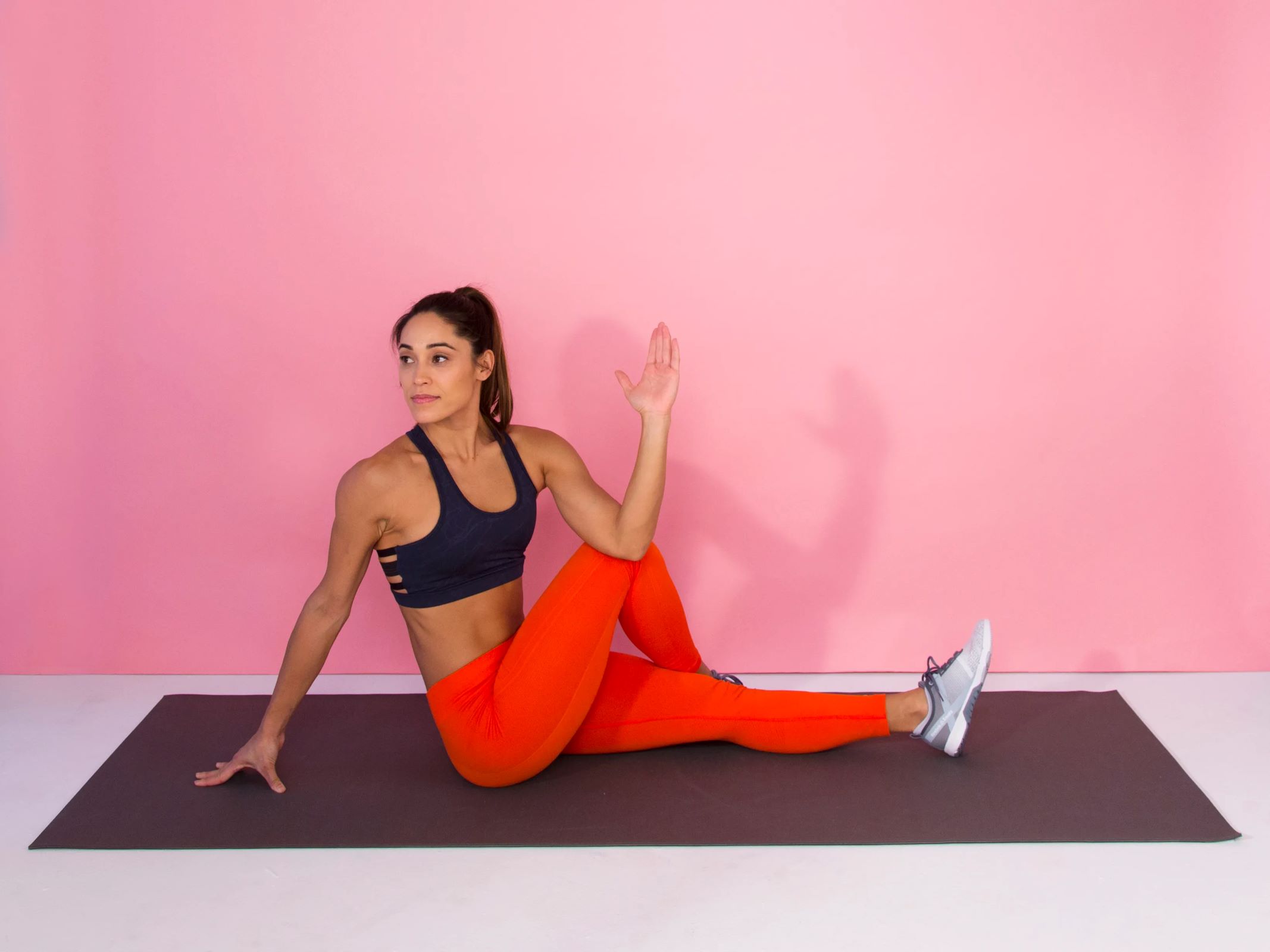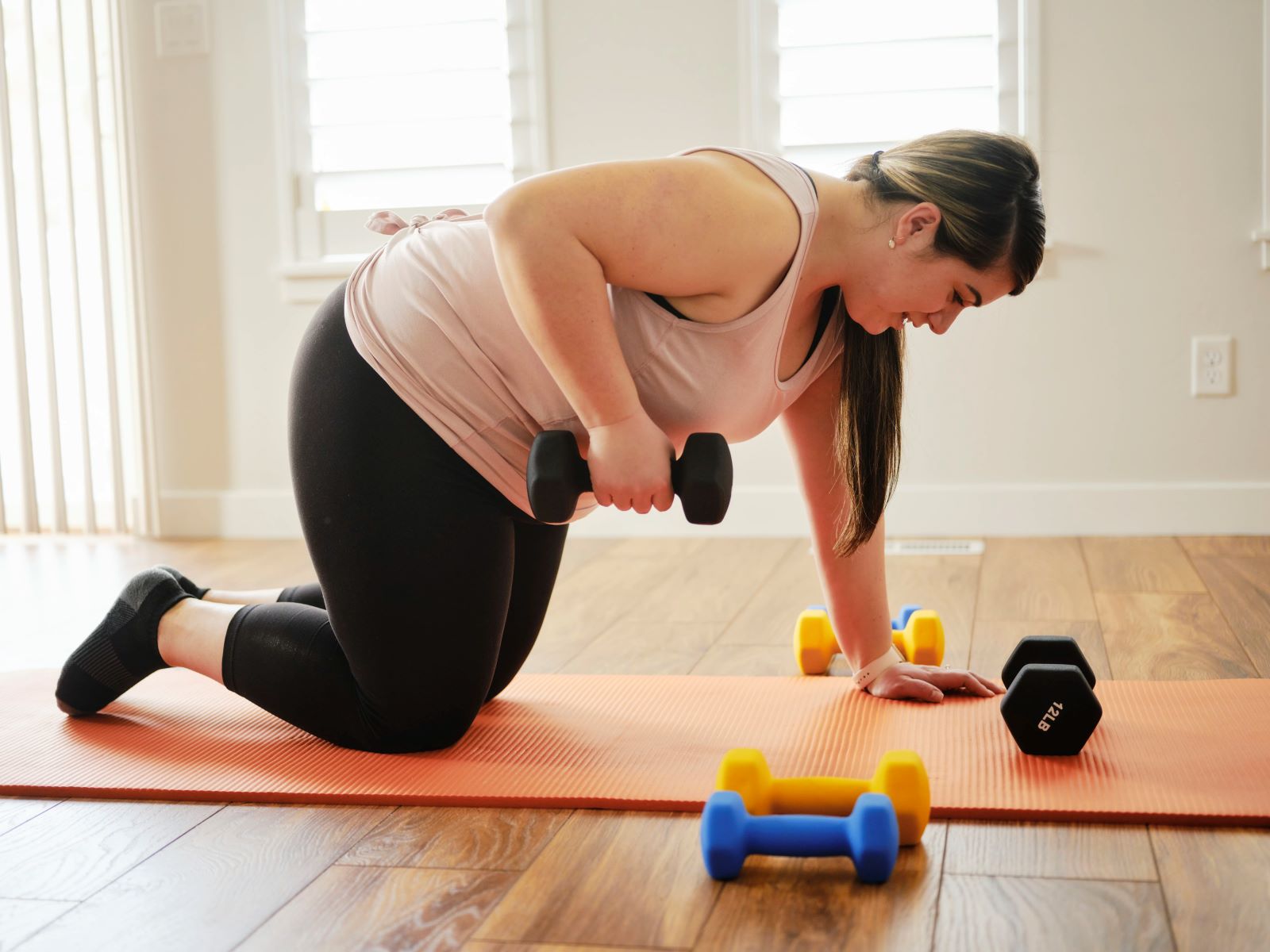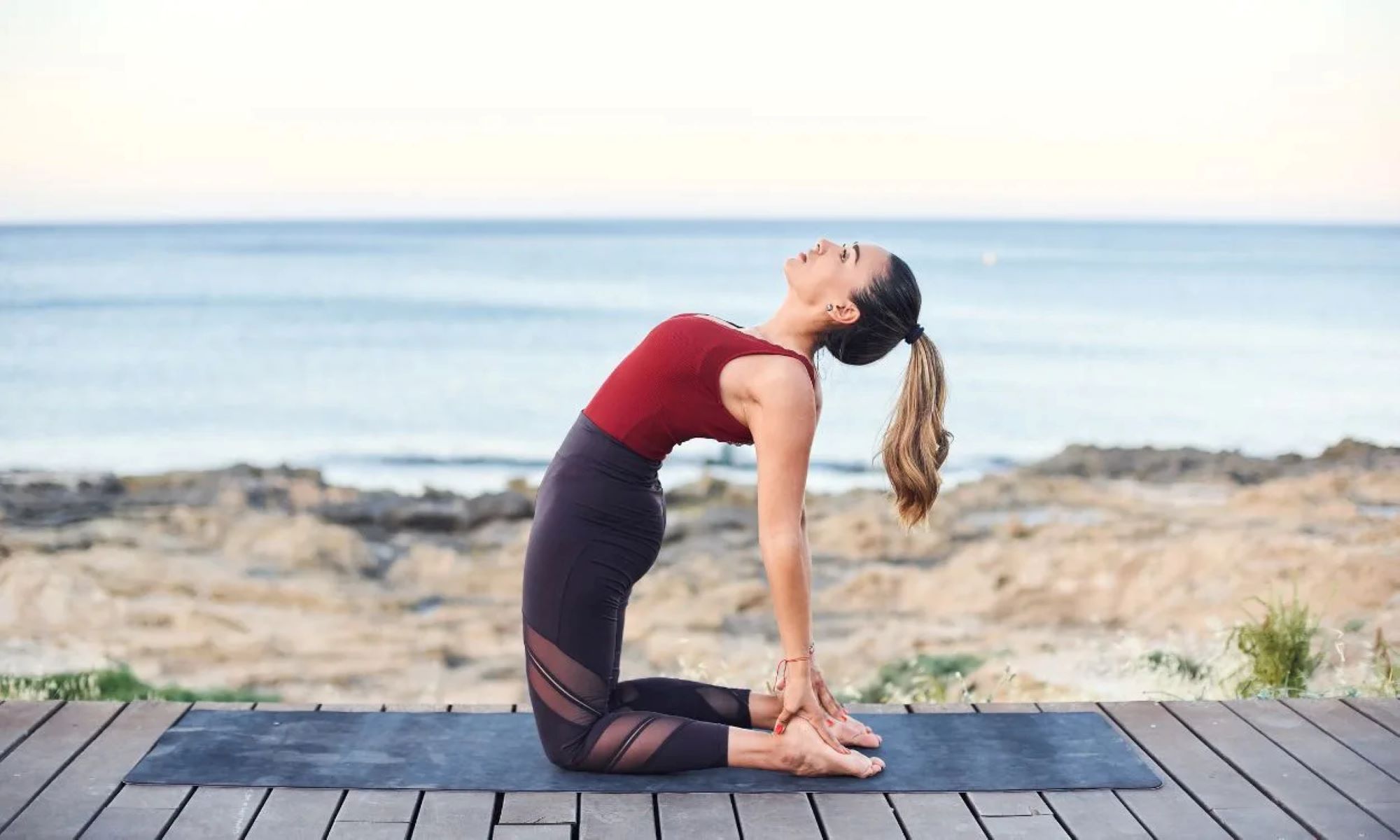

Featured
Why Stretch After Workout
Modified: August 19, 2023
Discover the importance of stretching after your workout with our featured article. Learn how it can improve flexibility, prevent injuries, and enhance recovery.
Introduction
Stretching after a workout is often overlooked or neglected by many individuals. While the main focus is usually on the workout itself, incorporating a stretching routine into your post-workout regimen is essential for overall fitness and well-being. Stretching not only helps to cool down your body but also provides numerous benefits that can enhance your fitness journey.
Stretching is a form of physical exercise that involves lengthening and elongating the muscles and surrounding tissues. It is commonly done by extending the limbs or bending the body into various positions. The primary aim of stretching is to increase muscle flexibility and range of motion. When done correctly, it can significantly improve athletic performance, prevent injuries, and promote muscle recovery.
After an intense workout, your muscles are warm and more pliable, making it an opportune time to perform stretching exercises. It helps to relax and rejuvenate your body, reducing the risk of muscle tightness, soreness, and potential injuries. Incorporating stretching into your post-workout routine can play a pivotal role in maintaining a healthy and well-balanced fitness regimen.
In this article, we will explore the importance of stretching and the benefits it provides after a workout. We will also discuss different types of stretching exercises, proper technique, and common mistakes to avoid. By understanding the significance of stretching and implementing it into your fitness routine, you can optimize your overall performance and well-being.
Importance of Stretching
Stretching is an integral part of any fitness routine and should not be underestimated or overlooked. It plays a crucial role in maintaining a healthy and balanced body. Let’s explore the importance of stretching:
1. Increased Flexibility: Stretching helps to improve flexibility by increasing the range of motion in your joints and muscles. This increased flexibility enhances your overall athletic performance, allowing you to move more freely and with greater ease.
2. Injury Prevention: Regular stretching helps to prevent injuries by keeping your muscles and joints supple and healthy. It increases the elasticity of your muscles, reducing the risk of strains, sprains, and other potential injuries. Additionally, stretching helps to correct muscle imbalances, which can contribute to improper mechanics and increased injury risk.
3. Muscle Recovery: Stretching after a workout helps to flush out waste products, such as lactic acid, that accumulate in the muscles during exercise. This aids in the recovery process and reduces muscle soreness. Stretching also promotes proper blood flow to the muscles, delivering essential nutrients and oxygen, which aids in healing and repair.
4. Improved Posture: Regular stretching can help improve your posture by lengthening tight muscles that contribute to poor alignment. It helps to counteract the negative effects of prolonged sitting and helps maintain proper alignment of the spine and joints.
5. Reduced Muscle Tension: Stretching can help alleviate muscle tension and tightness that commonly occur due to stress, sedentary lifestyles, or intense workouts. It promotes relaxation of the muscles and can provide a sense of overall well-being.
6. Mental Relaxation: Stretching not only benefits your physical body but also has a positive impact on your mental well-being. It provides an opportunity to slow down, focus on your body, and relax your mind. It can be a form of mindfulness practice that helps reduce stress and tension.
Considering the numerous benefits it offers, stretching should be an integral part of your fitness routine. Incorporating it into your post-workout regimen can help you reap the rewards and improve your overall well-being.
Benefits of Stretching after a Workout
Stretching after a workout is a crucial component of a well-rounded fitness routine. It provides numerous benefits that can enhance your overall fitness and well-being. Let’s explore some of the key benefits of stretching after a workout:
1. Enhanced Flexibility: Stretching after a workout helps to improve flexibility by increasing the range of motion in your joints. It lengthens the muscles and connective tissues, allowing you to move more freely and with greater ease. Enhanced flexibility can improve athletic performance and reduce the risk of injuries.
2. Improved Blood Circulation: Stretching increases blood flow to the muscles, delivering oxygen and important nutrients. This helps to promote muscle recovery and repair, as well as remove waste products such as lactic acid that can build up during intense exercise. Improved circulation also aids in maintaining healthy blood pressure levels.
3. Injury Prevention: Proper stretching after a workout can help prevent injuries by improving muscle flexibility and joint mobility. It reduces muscle tightness and imbalances, which can lead to strains and sprains. By maintaining optimal flexibility, you decrease the risk of overloading muscles and joints during subsequent workouts.
4. Muscle Recovery: Stretching after a workout plays a key role in muscle recovery. It helps to relax and lengthen the muscles, reducing post-workout muscle tension and soreness. Stretching also helps to remove metabolic waste products that accumulate during exercise, allowing for faster recovery and reduced muscle fatigue.
5. Reduced Muscle Soreness: Engaging in stretching exercises after a workout can help alleviate muscle soreness. It enhances blood flow to the muscles, facilitating the removal of waste products and reducing inflammation. This can result in less post-workout discomfort and a faster recovery time.
6. Improved Muscle Imbalances: Stretching helps to address muscle imbalances that may occur due to repetitive movements or favoring certain muscle groups during workouts. It promotes equal muscle length and strength, improving overall muscle balance and reducing the risk of overuse injuries.
By incorporating stretching into your post-workout routine, you can experience these benefits and optimize your fitness journey. Remember to always prioritize proper form and technique while performing stretching exercises to maximize their effectiveness.
Enhanced Flexibility
Enhanced flexibility is one of the key benefits of stretching after a workout. It refers to the ability of your muscles and joints to move through a wider range of motion. Here’s why enhanced flexibility is crucial:
1. Increased Range of Motion: Regular stretching after a workout helps to increase the range of motion in your joints. This allows you to perform exercises and everyday activities with greater ease. Whether you’re an athlete looking to improve your athletic performance or someone who wants to maintain mobility as you age, enhanced flexibility can make a significant difference.
2. Improved Muscle Elasticity: Stretching aids in improving muscle elasticity, which is the ability of your muscles to lengthen and return to their original position. This elasticity is crucial for functional movements and helps to prevent muscle strains and tears. By improving muscle elasticity, you can achieve a greater range of motion and reduce the risk of injury during physical activities.
3. Enhanced Joint Health: Stretching after a workout helps to maintain optimal joint health by increasing flexibility. It improves the lubrication of the joint capsules, reduces stiffness, and enhances the synovial fluid’s ability to nourish and protect the joint structures. This can have a positive impact on joint health and reduce the risk of joint-related issues such as arthritis.
4. Improved Performance: Enhanced flexibility can significantly improve athletic performance. It allows your body to move efficiently and effectively during workouts or sports activities. With greater flexibility, you can achieve better form and technique, generate more power, and reduce the risk of muscle imbalances that can hinder performance.
5. Injury Prevention: Maintaining good flexibility can help prevent injuries, especially those related to overuse or sudden movements. When your muscles are flexible, they can better absorb the impact of physical stresses, reducing the risk of strains, sprains, and tears. It also helps to distribute the workload evenly across your muscles, minimizing the risk of overloading one muscle or joint.
6. Improved Posture: Flexibility plays a crucial role in maintaining good posture. Tight muscles can pull your body out of alignment, leading to postural imbalances. By incorporating stretching exercises into your post-workout routine, you can help lengthen tight muscles and maintain better posture, reducing the risk of musculoskeletal issues.
Remember to always perform stretching exercises with proper form and technique to maximize the benefits and avoid injury. By regularly stretching after a workout, you can enhance your flexibility and enjoy the numerous advantages it brings to your overall fitness and well-being.
Improved Blood Circulation
Stretching after a workout not only benefits your muscles but also improves blood circulation throughout your body. Here’s how improved blood circulation can positively impact your overall well-being:
1. Delivery of Oxygen and Nutrients: When you stretch after a workout, it increases blood flow to your muscles. This improved circulation aids in the delivery of oxygen and essential nutrients, such as glucose and amino acids, to your muscle cells. These nutrients are vital for muscle repair and growth, allowing your muscles to recover more efficiently.
2. Removal of Waste Products: During exercise, metabolic waste products such as lactic acid can build up in your muscles. This can lead to fatigue and muscle soreness. By stretching after a workout, you stimulate blood circulation, which helps to flush out these waste products. This accelerates the recovery process and reduces muscle soreness.
3. Enhanced Warm-Up and Cool-Down: Stretching is an excellent way to warm up and cool down your muscles before and after a workout. It increases blood flow, which warms up the muscles and prepares them for the upcoming physical activity. Stretching also acts as a cooldown, gradually decreasing your heart rate and helping your body return to a resting state while maintaining proper blood circulation.
4. Reduction of Inflammation: Improved blood circulation can aid in reducing inflammation within your body. Inflammatory markers, such as cytokines and prostaglandins, can accumulate in your muscles during intense exercise. Stretching after a workout helps to regulate these markers and reduce inflammation, promoting a faster recovery and reducing the risk of chronic inflammation-related issues.
5. Maintenance of Healthy Blood Pressure: Stretching after exercise promotes optimal blood flow, which can contribute to maintaining healthy blood pressure levels. Regular stretching can help prevent hypertension and reduce the risk of cardiovascular diseases by improving the efficiency of your circulatory system.
6. Improved Overall Health: Good blood circulation is essential for your overall health and well-being. It ensures that oxygen and nutrients reach all parts of your body, supporting the proper functioning of your organs and systems. By incorporating stretching into your post-workout routine, you can actively promote and maintain healthy blood circulation.
With improved blood circulation as a result of stretching after your workouts, you can experience enhanced muscle recovery, reduced muscle soreness, and improved overall physical health. It is important to remember that stretching should be done safely and mindfully to maximize these benefits and enjoy a healthier and more active lifestyle.
Injury Prevention
Preventing injuries is a top priority for anyone engaging in physical activity or exercise. Incorporating stretching into your post-workout routine is an effective strategy for injury prevention. Here’s why stretching plays a crucial role in keeping you safe and injury-free:
1. Improved Muscle Flexibility: Stretching increases the flexibility and elasticity of your muscles. This enhanced flexibility helps to prevent muscle strains and tears. When your muscles are more pliable, they can withstand more stress and strain, reducing the risk of injury during workouts or physical activities.
2. Enhanced Joint Range of Motion: Stretching after a workout helps to improve joint flexibility and mobility. This allows your joints to move through a wider range of motion, decreasing the risk of joint stiffness and protecting them from potential injuries. A well-stretched joint is better equipped to handle sudden movements and varying physical demands.
3. Corrects Muscle Imbalances: Regular stretching can help correct muscle imbalances, which occur when certain muscles are stronger or tighter than others. Muscle imbalances can contribute to poor posture, faulty movement patterns, and increased injury risk. By stretching tight muscles and strengthening weak muscles, you restore balance and minimize the risk of overloading certain muscle groups during workouts.
4. Promotes Proper Alignment: Stretching after a workout helps to counteract the negative effects of repetitive movements or prolonged sitting. It aids in maintaining proper alignment of the spine, joints, and muscles. Proper alignment reduces the stress on your body’s tissues, minimizing the risk of chronic pain, joint issues, and musculoskeletal injuries.
5. Increases Muscle Awareness: Stretching after a workout enhances your body awareness and proprioception, which is your ability to sense the position and movement of your body. This heightened awareness can help you detect any potential imbalances or weaknesses, allowing you to modify your movements and prevent injuries before they occur.
6. Gradual Warm-Up and Cool-Down: Stretching serves as both a warm-up and cool-down routine. Prior to a workout, stretching helps to prepare your muscles for the upcoming physical activity, increasing blood flow and flexibility. After a workout, it aids in the recovery process, gradually decreasing your heart rate and promoting muscle relaxation. These gradual transitions can help prevent sudden strain on your muscles, reducing the risk of injury.
By incorporating stretching into your post-workout routine, you can significantly reduce the risk of injuries and create a solid foundation for a safe and sustainable fitness journey. Remember to always perform stretching exercises correctly and listen to your body to prevent overstretching or straining your muscles.
Muscle Recovery
Muscle recovery is an essential aspect of any fitness regimen. Incorporating stretching into your post-workout routine plays a vital role in aiding the recovery process. Here’s how stretching promotes muscle recovery:
1. Relaxation of Muscles: After an intense workout, your muscles can become tense and tight. Stretching helps to relax the muscles, reducing muscle tension and promoting a state of relaxation. This relaxation allows for better blood flow and nutrient delivery, supporting the recovery process.
2. Increased Blood Flow: Stretching after a workout increases blood flow to the muscles. This enhanced circulation helps to deliver oxygen, nutrients, and important components for muscle repair, such as amino acids, to the muscle fibers. The increased blood flow also aids in removing waste products, such as lactic acid and other metabolic byproducts, that contribute to muscle fatigue and soreness.
3. Improved Nutrient Delivery: Stretching promotes the delivery of nutrients to your muscles. As blood flow increases during stretching, it brings essential nutrients that are necessary for muscle recovery and repair. These nutrients, including proteins, vitamins, and minerals, are crucial for rebuilding and restoring muscle tissues damaged during exercise.
4. Accelerated Waste Removal: Stretching stimulates lymphatic circulation, which helps remove metabolic waste products from your muscles. By flushing out waste products like lactic acid, stretching aids in reducing muscle soreness and fatigue. This accelerates the recovery process, allowing your muscles to bounce back faster between workouts.
5. Reduction of Muscle Soreness: Engaging in stretching exercises after a workout can help alleviate muscle soreness. It helps to increase blood flow and flush out the byproducts of intense exercise, thereby reducing inflammation and soreness. Stretching also helps to lengthen tight muscles and relieve any muscular tension that may contribute to post-workout discomfort.
6. Relaxation and Mental Well-being: Stretching after a workout not only benefits your physical body but also provides a mental boost. It offers a moment of relaxation and mindfulness, allowing you to focus on your body and create a sense of overall well-being. This mental relaxation can contribute to reduced stress levels and improved recovery.
By incorporating stretching into your post-workout routine, you can promote muscle recovery and enhance your overall fitness journey. Remember to stretch gently and avoid any pain or discomfort. Listen to your body’s cues and adjust the intensity and duration of your stretches as needed.
Reduced Muscle Soreness
One common complaint after a workout is muscle soreness, also known as delayed onset muscle soreness (DOMS). Incorporating stretching into your post-workout routine can help reduce muscle soreness. Here’s how stretching contributes to alleviating this discomfort:
1. Increased Blood Flow: Stretching after a workout promotes increased blood flow to the muscles. This improved circulation helps to deliver oxygen and nutrients to the muscles, aiding in the recovery process. The increased blood flow also helps to flush out metabolic byproducts, such as lactic acid, which can accumulate during exercise and contribute to muscle soreness.
2. Reduction of Muscle Tension: Stretching helps to alleviate muscle tension, which can contribute to muscle soreness. It releases tightness in the muscles and promotes relaxation, reducing the strain on the muscles. By relieving muscle tension, stretching can help alleviate the soreness and discomfort associated with DOMS.
3. Decreased Inflammation: Stretching has anti-inflammatory effects on the body. It helps to reduce inflammation in the muscles, which can occur as a result of intense workouts. By decreasing inflammation, stretching can alleviate the pain and swelling associated with muscle soreness, allowing for a faster recovery.
4. Improved Flexibility: Regular stretching improves muscle flexibility and joint range of motion. This enhanced flexibility helps to reduce the strain on the muscles and joints during exercise. The less strain placed on the muscles, the lower the risk of developing excessive soreness. Additionally, increased flexibility supports proper form and technique, which can prevent excessive stress on specific muscle groups.
5. Psychological Relief: Stretching after a workout provides psychological relief, which can indirectly contribute to reducing muscle soreness. It offers a sense of relaxation and mental well-being. By alleviating stress and promoting a positive mindset, stretching can help decrease perceived pain and discomfort associated with muscle soreness.
6. Lactic Acid Removal: Stretching aids in the removal of lactic acid, a byproduct of intense exercise that can contribute to muscle soreness. By promoting circulation and stimulating lymphatic flow, stretching helps to flush out lactic acid and other waste products from the muscles. This can help minimize post-workout soreness and improve recovery time.
By incorporating stretching into your post-workout routine, you can experience reduced muscle soreness and recover more quickly. It is important to note that stretching should be done gently and without causing pain. Listen to your body’s signals and adjust the intensity and duration of your stretches accordingly. Stretching in moderation can be an effective tool for managing muscle soreness and improving your overall recovery after workouts.
Different Types of Stretching Exercises
When it comes to stretching, there are various techniques and methods you can incorporate into your post-workout routine. Each type of stretching exercise offers unique benefits. Let’s explore some of the different types of stretching exercises:
1. Static Stretching: This is perhaps the most common form of stretching. Static stretching involves holding a stretch for a prolonged period, usually around 15-30 seconds, without any bouncing or movement. It helps to improve flexibility and relaxes the muscles. Static stretches are ideal for targeting specific muscle groups and are typically performed after a workout when your muscles are warm.
2. Dynamic Stretching: Dynamic stretching involves moving parts of your body through a full range of motion. Unlike static stretching, dynamic stretching involves continuous movement. It is often used as a warm-up before a workout to prepare the muscles for activity. Dynamic stretches help improve mobility, increase blood flow, and enhance overall athletic performance.
3. Active Isolated Stretching: Active Isolated Stretching (AIS) focuses on targeting specific muscles or muscle groups. It involves actively contracting the muscle opposite to the one you want to stretch, then holding the stretch for just 2-3 seconds. This method helps to improve flexibility, increase mobility, and promote better muscle coordination.
4. Proprioceptive Neuromuscular Facilitation (PNF) Stretching: PNF stretching utilizes a combination of stretching and contracting muscles to enhance flexibility. It involves a series of contractions and stretches, often in partnership with a partner or a resistance band. PNF stretching helps to improve flexibility and range of motion by facilitating reciprocal muscle inhibition and autogenic inhibition.
5. Ballistic Stretching: Ballistic stretching involves using momentum and bouncing movements to reach an extended range of motion. It uses quick, repetitive bouncing motions and is often used by athletes to improve explosive power. However, caution should be exercised with ballistic stretching, as it may increase the risk of injury if not performed correctly.
6. Active Stretching: Active stretching involves using your own strength and opposing muscle groups to stretch a particular muscle. It is typically done without any external assistance or equipment. Active stretching improves flexibility, strengthens muscles, and enhances body awareness and control.
It’s important to remember that different stretching techniques are suitable for different purposes and individuals. Consider incorporating a combination of these stretching exercises into your routine to reap the most benefits. Experiment with various techniques and find what works best for your body and goals. Additionally, always prioritize proper form, listen to your body, and avoid overstretching or bouncing, which can lead to injury.
Static Stretching
Static stretching is a widely practiced and traditional form of stretching that can be incorporated into your post-workout routine. It involves holding a stretch for a specific duration without any bouncing or movement. Here’s what you need to know about static stretching:
1. Benefits of Static Stretching: Static stretching helps to improve flexibility and muscular relaxation. It targets specific muscle groups, allowing you to elongate and lengthen the muscles. By holding the stretch for an extended period, usually around 15-30 seconds, you can effectively increase muscle length and overall flexibility.
2. When to Perform Static Stretching: Static stretching is typically performed after a workout or physical activity when your muscles are warm and more pliable. Engaging in static stretches after exercise helps to cool down the body, slow down the heart rate, and relax the muscles. Post-workout static stretching can aid in preventing muscle tightness and reduce the risk of muscle soreness.
3. Proper Technique for Static Stretching: To perform a static stretch, choose a specific muscle or muscle group to target. Gently stretch the muscle to the point of mild tension, avoiding any pain. Hold the stretch for 15-30 seconds, focusing on deep and relaxed breathing. It is essential to maintain proper posture and alignment during static stretching to maximize the benefits and minimize the risk of injury.
4. Common Static Stretches: There is a wide range of static stretches that can target various muscle groups. Some common static stretches include hamstring stretches, calf stretches, quadriceps stretches, chest stretches, and shoulder stretches. You can find specific static stretching exercises tailored to your fitness goals or areas of focus.
5. Safety Considerations: While static stretching has many benefits, it is important to perform it correctly and safely. Never force a stretch or bounce while holding a static stretch, as this can cause muscle strain or injury. If you have any pre-existing injuries or musculoskeletal conditions, consult with a healthcare professional or a certified trainer to ensure that static stretching is suitable for your specific needs.
6. Incorporating Static Stretching into Your Routine: Consider incorporating static stretching into your post-workout routine to reap the benefits it offers. Perform static stretches for the major muscle groups you engaged during your workout. Remember that static stretching is just one component of a well-rounded fitness routine, and incorporating other forms of stretching, such as dynamic stretching or active stretching, can provide additional advantages.
Static stretching can be an effective tool for improving flexibility and muscle relaxation. By integrating it into your post-workout routine and practicing it regularly, you can maintain a healthy range of motion, prevent muscle imbalances, and promote overall flexibility and well-being.
Dynamic Stretching
Dynamic stretching is a form of stretching that involves moving parts of your body through a full range of motion in a controlled and deliberate manner. Unlike static stretching, which involves holding a stretch for a prolonged period, dynamic stretching incorporates continuous movement. Here’s what you need to know about dynamic stretching:
1. Benefits of Dynamic Stretching: Dynamic stretching helps to improve flexibility, enhance muscle activation, and increase body temperature. It is an effective way to prepare your body for physical activity, as it promotes mobility and range of motion in a specific muscle group or joint.
2. When to Perform Dynamic Stretching: Dynamic stretching is typically done as a warm-up before engaging in exercise or physical activity. It helps to increase blood flow, elevate heart rate, and initiate the neuromuscular system. By activating the muscles and increasing joint mobility, dynamic stretching prepares your body for the movements and demands of your workout.
3. Proper Technique for Dynamic Stretching: To perform a dynamic stretch, choose a movement that mimics the activity you are about to engage in. Move smoothly and progressively through the range of motion, gradually increasing the intensity or speed. It’s important to maintain control and avoid any jerking or bouncing movements. Focus on proper form and engage the targeted muscles throughout the dynamic stretch.
4. Sample Dynamic Stretches: There is a wide range of dynamic stretches that can be incorporated into your warm-up routine. Some examples include arm circles, walking lunges, high knees, leg swings, and trunk rotations. These exercises focus on actively moving the muscles and joints through their full range of motion.
5. Dynamic Stretching and Sport-Specific Movements: Dynamic stretching can be tailored to specific sports or activities. By incorporating movements that mimic the actions you will perform during the workout or sport, you can further enhance muscle activation and prepare your body for the specific demands of the activity. This can improve performance and reduce the risk of injuries associated with inadequate warm-up.
6. Safety Considerations: While dynamic stretching is generally safe when performed correctly, it is important to listen to your body and avoid any movements that cause pain or discomfort. If you have any pre-existing injuries or conditions, consult with a healthcare professional or a certified trainer to ensure that dynamic stretching is appropriate for you and your specific needs.
Dynamic stretching is an effective warm-up technique that can improve flexibility, range of motion, and muscle activation. By incorporating it into your pre-workout routine, you prepare your body for physical activity and reduce the risk of injury. Remember to perform dynamic stretching with proper technique, gradually increasing the intensity or speed as you warm up, and tailoring the movements to the specific activity you will be undertaking.
Active Isolated Stretching
Active Isolated Stretching (AIS) is a type of stretching exercise that incorporates active movement and muscle contraction to improve flexibility and range of motion. It involves targeting specific muscles or muscle groups and actively contracting the muscle opposite to the one you want to stretch. Here’s what you need to know about Active Isolated Stretching:
1. Benefits of Active Isolated Stretching: AIS helps to increase flexibility, enhance joint mobility, and improve muscle coordination. It focuses on specific muscles or areas of tightness, allowing for a deeper and more effective stretch. By actively contracting the opposing muscle, AIS promotes reciprocal inhibition, which helps to further relax the target muscle for a greater stretch.
2. How Active Isolated Stretching Works: To perform an Active Isolated Stretch, you first identify the muscle or muscle group you want to stretch. Then, you actively contract the muscle on the opposite side, holding the contraction for 2-3 seconds. This contraction helps to facilitate proprioceptive neuromuscular facilitation (PNF), encouraging the target muscle to relax and allowing for a deeper, safer, and more effective stretch. Active repetitions are performed, gradually increasing the stretch with each repetition.
3. When to Perform Active Isolated Stretching: Active Isolated Stretching can be incorporated into your warm-up routine or used as part of your post-workout cool-down. It is especially beneficial for targeting specific muscles that may be tight or need additional flexibility for your specific activities or sports.
4. Proper Technique for Active Isolated Stretching: When performing Active Isolated Stretching, it is important to move in a controlled and deliberate manner. Start with a gentle stretch and gradually increase the range of motion with each repetition. It is crucial to focus on deep and relaxed breathing throughout the stretch, allowing your body to relax into the movement and lengthen the targeted muscle.
5. Sample Active Isolated Stretches: Active Isolated Stretching can target various muscle groups. Some examples include hamstring stretches, quadriceps stretches, hip flexor stretches, and shoulder stretches. These stretches allow for active isolated contractions of the opposing muscles, promoting relaxation and an increased stretching effect.
6. Safety Considerations: As with any stretching exercise, it’s important to listen to your body and avoid any movements that cause pain or discomfort. Active Isolated Stretching should be performed with proper form and technique to prevent muscle strain or injury. If you have any pre-existing injuries or musculoskeletal conditions, consult with a healthcare professional or a certified trainer to ensure that Active Isolated Stretching is suitable for your specific needs.
Active Isolated Stretching is a targeted and effective method for improving flexibility and range of motion. By incorporating this technique into your stretching routine, you can enhance your overall athletic performance, reduce muscle tightness, and prevent possible injuries. Remember to perform Active Isolated Stretches in a controlled manner, paying attention to your body’s limitations and gradually increasing the stretch over time.
Proprioceptive Neuromuscular Facilitation (PNF) Stretching
Proprioceptive Neuromuscular Facilitation (PNF) stretching is a highly effective stretching technique that involves a combination of contraction and relaxation of specific muscles to improve flexibility and range of motion. It utilizes the body’s own neuromuscular reflexes to achieve a deeper stretch. Here’s what you need to know about PNF stretching:
1. Benefits of PNF Stretching: PNF stretching is known for its ability to rapidly increase flexibility and improve muscle performance. It helps to improve range of motion, promote muscular coordination, and enhance muscle strength. PNF stretching is widely utilized by athletes, physical therapists, and fitness enthusiasts to improve athletic performance and prevent injuries.
2. How PNF Stretching Works: PNF stretching involves stretching a specific muscle group and then contracting the muscle opposite to the one being stretched. This contraction is held for a few seconds before relaxing and moving into a deeper stretch. The cycle of contraction and release stimulates the proprioceptors (sensory receptors) in the muscles, signaling the body to allow for a deeper stretch with increased muscle relaxation.
3. Techniques of PNF Stretching: PNF stretching techniques include the Hold-Relax method and the Contract-Relax method. In the Hold-Relax method, the muscle is stretched for a brief period, followed by an isometric contraction of the stretched muscle against resistance. After the contraction, the muscle is relaxed, and a deeper stretch is achieved. In the Contract-Relax method, the muscle is stretched as before, but instead of an isometric contraction, the muscle is actively and concentrically contracted through its full range of motion before relaxing into a deeper stretch.
4. When to Perform PNF Stretching: PNF stretching is commonly performed after a warm-up or as part of a cool-down routine. It is especially beneficial for individuals looking to improve flexibility, recover from injuries, or enhance athletic performance. PNF stretching is often best done with a partner or with the assistance of a trained professional to ensure proper technique and safety.
5. Proper Technique for PNF Stretching: To perform PNF stretching, it is important to have a clear understanding of the technique. Remember to communicate effectively with your stretching partner or trainer and follow the specific instructions provided. It is crucial to start with a gentle stretch and gradually increase the intensity over multiple cycles of contraction and relaxation.
6. Safety Considerations: While PNF stretching can be highly effective, it is important to approach it with caution and ensure proper technique. It is recommended to work with a knowledgeable partner or a qualified professional who can guide you through the stretches and ensure safety. If you have any pre-existing injuries or conditions, consult with a healthcare professional or a certified trainer to determine if PNF stretching is suitable for you.
Proprioceptive Neuromuscular Facilitation (PNF) stretching is an advanced and effective method for improving flexibility and range of motion. By incorporating this technique into your stretching routine under proper guidance, you can experience significant gains in flexibility, muscle coordination, and athletic performance.
Best Time to Stretch after a Workout
Stretching after a workout is crucial for maximizing the benefits of your exercise routine. While there is no set rule for the perfect time to stretch, there are a few factors to consider when determining the best time for post-workout stretching:
1. Post-Workout Cool-Down: It is generally recommended to incorporate stretching into your cool-down routine after your workout. After completing your exercise session, gradually decrease your intensity by engaging in lower-intensity exercises or movements. This helps to gradually bring your heart rate and body temperature back to normal levels. Following this, include static or dynamic stretching exercises to help relax and elongate your muscles.
2. Warm Muscles: Stretching is most effective when your muscles are warm. Performing a quick warm-up before your workout, such as light cardio exercises or dynamic movements, can increase blood flow to your muscles, raise their temperature, and prepare them for stretching. Warm muscles are more pliable and less prone to injury, allowing for a deeper and more effective stretch.
3. Immediate Post-Workout: Stretching immediately after your workout can provide numerous benefits. During your workout, your muscles undergo stress, and stretching helps to release tension, realign muscle fibers, and increase blood circulation. Stretching at this time can also aid in the removal of metabolic waste products, such as lactic acid, which can contribute to muscle soreness.
4. Prioritize Static Stretching: While dynamic stretching is an effective warm-up, static stretching is more suitable for post-workout stretching, especially during your cool-down period. Static stretching allows for a sustained stretch, helping to lengthen the muscles and improve flexibility. Holding stretches for 15-30 seconds, without any bouncing or movement, can help relax and elongate the muscles after your workout.
5. Listen to Your Body: Pay attention to how your body feels and adapt your stretching routine accordingly. If you feel particularly tight in specific muscle groups, spend more time stretching those areas. On the other hand, if you feel fatigued or excessively sore, be gentle with your stretches and avoid overexertion. Remember that stretching should feel like a gentle pull, not pain or discomfort.
6. Individual Preference: Ultimately, the best time to stretch after a workout depends on your personal preference and what feels right for your body. Some individuals prefer to stretch immediately after their workout to capitalize on the benefits, while others may prefer to rest briefly before incorporating stretching into their cool-down. Experiment with different timing options and listen to your body to determine what works best for you and your recovery needs.
Remember that stretching should always be done with proper technique and mindfulness. Whether you choose to stretch immediately after your workout or as part of your cool-down routine, incorporating regular post-workout stretching can help improve flexibility, prevent muscle imbalances, reduce muscle tension, and enhance overall recovery.
Proper Technique for Stretching
Stretching is an essential component of any fitness routine, and performing stretches with proper technique is crucial for maximizing their effectiveness and minimizing the risk of injury. Here are some key considerations for maintaining proper technique while stretching:
1. Warm-Up: Before you begin your stretching routine, it’s important to warm up your muscles. Engage in light cardio exercises or dynamic movements to increase blood flow and raise your muscle temperature. This prepares your muscles for stretching and makes them more pliable, reducing the risk of strains or other injuries.
2. Dynamic Movements: For pre-workout stretching, focus on dynamic movements that mimic the exercises or activities you will be performing. Dynamic stretching involves active movements that take your joints through their full range of motion. It helps to activate the muscles, prepare them for movements, and improve your overall performance.
3. Static Hold: When performing static stretches, hold the stretch position for 15 to 30 seconds. Avoid bouncing or jerking movements, as this can strain your muscles or cause injury. Instead, find a comfortable stretch position and maintain a steady hold. Focus on relaxing into the stretch, allowing your muscles to gradually lengthen.
4. Breathe: Proper breathing is essential during stretching. Take deep, slow breaths and try to relax as you exhale. Breathing deeply helps to oxygenate your muscles and promotes a sense of relaxation, allowing for a deeper stretch.
5. Focus on Targeted Muscles: Concentrate on the specific muscles or muscle groups you are stretching. Visualize the muscles lengthening and releasing tension with each exhale. Pay attention to any sensations or discomfort you may feel and adjust the intensity of the stretch accordingly. Aim to feel a gentle pull or tension in the muscle, but never stretch to the point of pain.
6. Symmetry and Balance: Stretch both sides of your body equally to maintain symmetry and balance. If you feel more tension or tightness on one side, spend some extra time stretching that area. Remember that stretching should be a balanced practice that promotes flexibility in all muscle groups.
7. Stay Consistent: Regularity is key when it comes to stretching. To maintain and improve flexibility, make stretching a regular part of your fitness routine. Aim for at least a few minutes of stretching after every workout or physical activity session.
8. Listen to Your Body: Lastly, always listen to your body and respect its limits. Stretching should never cause sharp or intense pain. Be mindful of any existing injuries or medical conditions, and if necessary, consult with a healthcare professional or a qualified trainer for guidance on modifications or alternative stretches.
By following these guidelines and practicing proper technique, you can make the most out of your stretching routine. Whether you’re stretching before a workout or during a cool-down, maintaining proper technique will help you improve flexibility, prevent injuries, and optimize your overall performance and well-being.
Common Stretching Mistakes to Avoid
Stretching is an important aspect of any fitness routine, but it’s essential to perform stretching exercises correctly to avoid potential pitfalls and maximize the benefits. Here are some common stretching mistakes to avoid:
1. Bouncing: One of the most common mistakes is bouncing or using a bouncing motion while stretching. This can lead to overstretching the muscles, causing excessive strain and potential injury. Instead, focus on static stretching by holding a position without any bouncing or jerking movements.
2. Holding Your Breath: It’s common to unintentionally hold your breath while stretching, but proper breathing is crucial. Holding your breath can lead to increased muscle tension and restrict the oxygen flow to your muscles. Remember to take slow, deep breaths and exhale as you relax into the stretch.
3. Stretching Cold Muscles: Stretching cold muscles increases the risk of injury. Always warm up your body with light cardio exercises or dynamic movements before starting your stretch routine. Warming up the muscles increases blood flow and makes them more pliable, reducing the risk of strains.
4. Ignoring Both Sides: It’s important to stretch both sides of your body equally. Neglecting to stretch one side can result in muscle imbalances and asymmetry. Make sure to give equal attention to both sides to maintain balance and prevent potential issues down the line.
5. Overstretching: While stretching is beneficial, overstretching can lead to muscle strains or injuries. It’s important to find a comfortable point of tension in your stretch without experiencing any pain. Never push your body beyond its limits, and avoid competing with others or trying to achieve extreme flexibility.
6. Rushing Through Stretches: Adequate time should be allocated for each stretch. Rushing through stretches may not allow your muscles enough time to fully lengthen and release tension. Take the time to hold each stretch for 15 to 30 seconds, allowing your muscles to relax and elongate gradually.
7. Neglecting Major Muscle Groups: It’s common for individuals to focus solely on their favorite exercises or muscles, neglecting other areas of the body. Make sure to include stretches that target major muscle groups such as the hamstrings, quadriceps, calves, chest, back, and shoulders to maintain balance and prevent muscle imbalances.
8. Stretching Through Pain: Stretching should never be painful. If you feel sharp or intense pain while stretching, it’s a sign to stop immediately. Pain may indicate an injury or muscle strain. Consult a healthcare professional if you experience persistent pain during stretches.
By avoiding these common stretching mistakes and adopting proper technique, you can safely and effectively incorporate stretching into your fitness routine. Remember to focus on controlled, static stretching, warm up your muscles beforehand, and listen to your body to prevent injuries and ensure optimal results.
Conclusion
Incorporating stretching into your post-workout routine is essential for maintaining overall fitness and well-being. Stretching offers numerous benefits, including enhanced flexibility, improved blood circulation, injury prevention, muscle recovery, and reduced muscle soreness.
Proper technique is crucial when it comes to stretching. Make sure to warm up your muscles before stretching, either with light cardio exercises or dynamic movements. Focus on static stretching after a workout to elongate and relax the muscles. Take deep breaths, avoid bouncing or jerking movements, and respect your body’s limits.
Be mindful of common stretching mistakes, such as bouncing, overstretching, or neglecting both sides of your body. Avoid rushing through stretches and always listen to your body. Some other key points to remember include stretching warm muscles, creating balance by targeting major muscle groups, and never stretching through pain.
Overall, incorporating stretching into your post-workout routine is a valuable practice for optimal physical health and performance. By following proper techniques, you can optimize the benefits of stretching, prevent injuries, and improve flexibility and muscle recovery.
Remember, every individual is unique, and it’s important to find a stretching routine that works best for you. Consult with a certified trainer or healthcare professional if you have any specific concerns or questions regarding stretching exercises.









